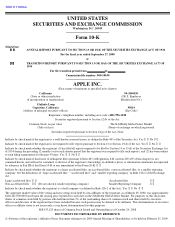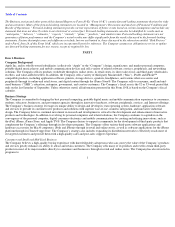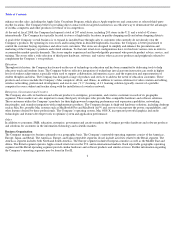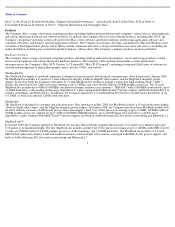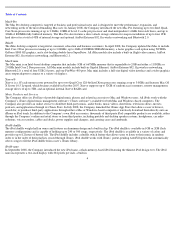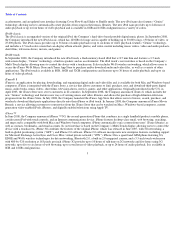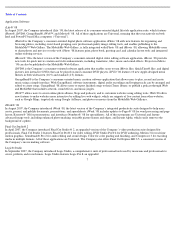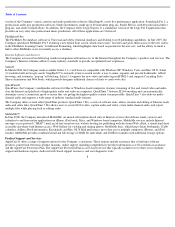Apple 2008 Annual Report Download - page 8
Download and view the complete annual report
Please find page 8 of the 2008 Apple annual report below. You can navigate through the pages in the report by either clicking on the pages listed below, or by using the keyword search tool below to find specific information within the annual report.
Table of Contents
accelerometer, and an updated user interface featuring Cover Flow® and Shake to Shuffle mode. The new iPod nano also features “Genius”
technology allowing users to automatically create playlists from songs in their music libraries. The new iPod nano provides up to 24 hours of
audio playback or up to four hours of video playback and is available in 8GB and 16GB configurations in a variety of colors.
iPod® classic
The iPod classic is an upgraded version of the original iPod, the Company’s hard-drive based portable digital music player. In September 2008,
the Company introduced the new iPod classic, which has 120GB of storage and is capable of holding up to 30,000 songs, 150 hours of video, or
25,000 photos. The iPod classic provides up to 36 hours of audio playback or up to six hours of video playback, features “Genius” technology,
and includes a 2.5-
inch color screen that can display album artwork, photos, and video content including music videos, video and audio podcasts,
short films, television shows, movies, and games.
iPod® touch
In September 2008, the Company introduced the new iPod touch, a flash-memory-based iPod that is 8.5 mm thin and features a 3.5-inch
widescreen display, “Genius” technology, a built-in speaker, and an accelerometer. The iPod touch’s user interface is based on the Company’s
Multi-Touch display allowing users to control the device with a touchscreen. It also includes Wi-Fi wireless networking, which allows users to
access the iTunes Wi-Fi Music Store and iTunes App Store to purchase and/or download audio and video files, as well as a variety of other
applications. The iPod touch is available in 8GB, 16GB and 32GB configurations and features up to 36 hours of audio playback and up to six
hours of video playback.
iTunes® 8
iTunes is an application for playing, downloading, and organizing digital audio and video files and is available for both Mac and Windows-
based
computers. iTunes is integrated with the iTunes Store, a service that allows customers to find, purchase, rent, and download third-party digital
music, audio books, music videos, short films, television shows, movies, games, and other applications. Originally introduced in the U.S. in
April 2003, the iTunes Store now serves customers in 22 countries. In September 2008, the Company announced iTunes 8, which includes the
new “Genius” technology and features new ways of viewing music and video libraries and allows the purchase of high definition television
programs from the iTunes Store. In July 2008, the Company launched the iTunes App Store that allows users to browse, search, purchase, and
wirelessly download third-party applications directly onto their iPhone or iPod touch. In January 2008, the Company announced iTunes Movie
Rentals, a service allowing customers to rent movies from the iTunes Store that can be watched on Macs, Windows-based computers, current
generation video-enabled iPods, iPhones, and digitally enabled televisions using Apple TV.
iPhone™
In June 2008, the Company announced iPhone ™ 3G, the second-generation iPhone that combines in a single handheld product a mobile phone,
a widescreen iPod with touch controls, and an Internet communications device. iPhone features desktop-class email, web browsing, searching,
and maps and is compatible with both Macs and Windows-based computers. iPhone automatically syncs content from users’ iTunes libraries, as
well as contacts, bookmarks, and email accounts. Its user interface is based on the Company’s Multi-Touch display allowing users to control the
device with a touchscreen. iPhone 3G combines the features of the original iPhone, which was released in June 2007, with 3G networking, a
built-in global positioning system (“GPS”),
and iPhone 2.0 software. iPhone 2.0 software incorporates new enterprise features, including support
for Microsoft Exchange ActiveSync and Cisco IPsec virtual private network (“VPN”). iPhone 3G is a quad-band GSM phone featuring 3G,
EDGE and Wi-Fi wireless technologies for data networking, Bluetooth 2.0, a built-in 2.0 megapixel camera, and a 3.5-inch touch widescreen
with 480-by-320 resolution at 163 pixels per inch. iPhone 3G provides up to 10 hours of talk time on 2G networks and five hours using 3G
networks, up to five to six hours of web browsing, up to seven hours of video playback, or up to 24 hours of audio playback. It is available in
8GB and 16GB configurations.
5


